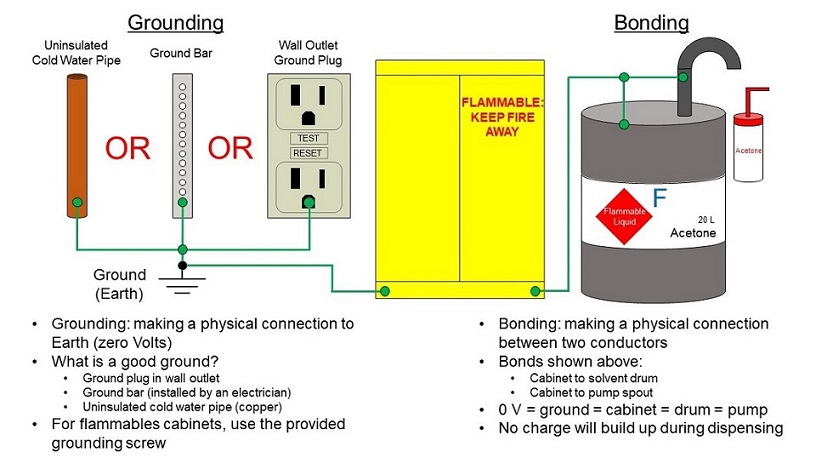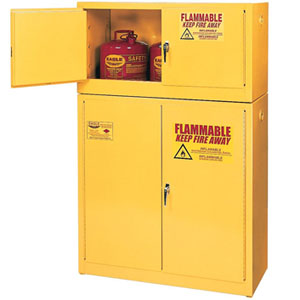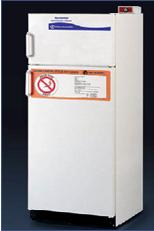Hazard Overview
Flammable liquids can be ignited easily by a flame, hot surface, or a spark generated by electricity or mechanical work. The highest hazard is posed by highly volatile solvents because the vapor can reach ignition sources several feet away. If the vapor is ignited, the fire can quickly reach the bulk liquid. A flammable vapor and air mixture with a specific concentration can explode violently. Vapors are usually heavier than air and will accumulate near the floor or bottom of the hood.
The flash point is the minimum temperature at which a liquid emits sufficient vapor to form an ignitable mixture with air near the surface of the liquid. Thus, a solvent with a flash point below room temperature is highly flammable. Flammable liquids are divided into different hazard categories depending on their boiling and flash points. The National Fire Protection Association (NFPA) and the Globally Harmonized System (GHS) use slightly different categories. A table with examples can be found at the end of this document.
Most flammable solvents are defatting to the skin and can be harmful or toxic if inhaled.
Safe Handling
- Always wear standard laboratory PPE to avoid skin contact: Closed-toe shoes, clothes that cover the legs, safety glasses, gloves, and a lab coat. The lab coat should be flame-resistant or, at a minimum, 100% cotton. Most synthetic material quickly melts if ignited.
- Keep sources of ignition away when handling flammable liquids. Never heat a flammable solvent with a Bunsen burner or other open flame. Be aware that there are many ignition sources in a laboratory such as outlets, electrical equipment, light fixtures, and static electricity build-up.
- Keep all containers of flammable solvents tightly closed when not in use.
- Use flammable solvents only in well-ventilated areas such as a chemical fume hood to avoid the build-up of an explosive atmosphere. Never pour large amounts while working on an open bench top, and never let flammable solvents evaporate while placed on an open bench top.
Transferring Large Amounts - Bonding and Grounding
When transferring flammable liquids from large containers (>4 L), to a smaller container, the flow of the liquid can create static electricity which could result in a spark. Static electricity build-up is possible whether using a pump or pouring the liquid. If the bulk container and receiving vessel are both metal, bond the two by firmly attaching a metal bonding strap or wire to both containers. Ground one of the containers by connecting it to a building ground. In campus buildings, cold water pipes and ground plugs in wall receptacles are the two simplest ways to access Earth ground. To ground a conductor to a cold water pipe, a wire can be clamped to the pipe. Note that for pipes, the wire must touch bare copper; painted, powder coated, or insulated surfaces will not work as a functional ground. Bare metal must touch bare metal for current to be able to flow.
If the receiving vessel is made of a non-conductive material such as glass or plastic, use a metal pipe or wire to ground the liquid in the receiving vessel. Also ground any conductive surfaces in contact with the container including the bulk vessel. Always transfer the liquid slowly as splashing and sloshing creates more static electricity.

Emergency Procedures
Accidental Exposure
Consult with the Safety Data Sheet for the chemical you are working with. For most chemicals, the following first aid measures are appropriate:
Skin Contact
Remove contaminated clothing and rinse off affected skin immediately with copious amounts of water for 15 min or until pain is relieved. If skin irritation is visible, seek medical attention.
Eye Contact
Use the eye wash to rinse eye thoroughly for at least 15 min, occasionally lifting upper and lower eyelids, rolling the eye balls around. Seek medical attention.
Inhalation
Move into fresh air immediately. Seek medical attention if symptoms persist. Provide the medical team with the Safety Data Sheet SDS for the chemical you were exposed to.
Spills
Any spills of a flammable solvent should be cleaned up immediately, using non-flammable absorbent pads or other inert absorbent material such as sand or cat litter. Have enough material readily available before working with flammables. Do not use paper towels to soak up flammable liquids as the paper contributes more flammable material. Place the used absorbent material into a heavy-duty plastic bag (if the solvent will not dissolve the plastic) or sealable container and dispose of as flammable waste through DRS.
Fires
Have a fire extinguisher readily available when working with flammables. An ABC extinguisher is suitable for most flammable liquids, but always consult the SDS for the proper fire extinguisher.
Storage
Maximum Allowable Quantities
The National Fire Protection Association's NFPA 45-Standard on Fire Protection for Laboratories Using Chemicals 2015 Edition limits the amount of flammable liquids that can be stored in a laboratory. The limits depend on the construction and fire safety rating of the building and room. Most buildings on campus fall under class C (low fire hazard). The allowable amounts for this class are outlined in the table below:
Table 1: Maximum Quantities of Flammable and Combustible Liquids in Class C labs
Class | Maximum Quantity per 100 sq. ft. | Maximum Quantity per Laboratory | Maximum Quantity per 100 sq. ft. | Maximum Quantity per Laboratory |
Without Flammable Cabinet | With Flammable Cabinet | |||
I | 7.5 L (2 gal) | 570 L (150 gal) | 15 L (4 gal) | 1136 L (300 gal) |
I, II and IIIA | 15 L (4 gal) | 757 L (200 gal) | 30 L (8 gal) | 1515 L (400 gal) |
*Material class I includes Class IA, IB, and IC flammable liquids and liquefied flammable gases. NFPA 45 does not place limits on Class IIIB materials.
Some newer buildings on campus may allow storage of larger quantities (Class B, moderate fire hazard). Contact F&S Campus Code Compliance & Fire Safety to find the limits for your lab.
Table 2: Maximum Quantities of Flammable and Combustible Liquids in Class B Labs
Class | Maximum Quantity per 100 sq. ft. | Maximum Quantity per Laboratory | Maximum Quantity per 100 sq. ft. | Maximum Quantity per Laboratory |
Without Flammable Cabinet | With Flammable Cabinet | |||
I | 20 L (5 gal) | 1136 L (300 gal) | 38 L (10 gal) | 1820 L (480 gal) |
I, II and IIIA | 38 L (10 gal) | 1515 L (400 gal) | 76 L (20 gal) | 3028 L (800 gal) |
*Material class I includes Class IA, IB, and IC flammable liquids and liquefied flammable gases. NFPA 45 does not place limits on Class IIIB materials.
Flammable Storage Cabinets
With a flammable storage cabinet, the allowable quantities are doubled. Only certified cabinets listed by Factory Mutual, Underwriter's Laboratory, or other qualified testing agencies should be purchased. The requirements for a flammable storage cabinet are:
- Cabinets shall be of steel having a thickness of not less than 0.044” (1.12mm) (18 gauge).
- The cabinet walls and doors shall be double-walled with 1 1/2” (38.1mm) airspace between walls.
- Doors shall be well fitted, self-closing, and equipped with a latching device.
Wooden cabinets shall meet the following requirements:
- The bottom, sides, and top shall be constructed of an exterior grade of plywood at least 1 inch in thickness, which shall not break down or delaminate under standard fire test conditions.
- All joints shall be rabbeted and shall be fastened in two directions with flathead wood screws.
- When more than one door is used, there shall be a rabbeted overlap of not less than 1 inch.
- Steel hinges shall be mounted in such a manner as to not lose their holding capacity due to loosening or burning out of the screws when subjected to fire.
- A raised sill or pan capable of holding 2 inches depth of liquid shall be provided at the bottom of the cabinet.
- Cabinets shall be painted inside and out with fire retardant paint.
All flammable storage cabinets must be clearly labeled with a sign that reads: "Flammable – Keep Fire Away".
Flammable storage cabinets should never be located by exit doors.
Flammable storage cabinets should not be used to store corrosives, as they may corrode the cabinet.
The venting of flammable storage cabinets is not recommended, as it reduces its fire protection effectiveness. If venting is required to prevent chemical exposure or to reduce odorous vapors, the installation has to be done by a qualified person. Contact Facilities and Services for this purpose.
Refrigerator and Freezer Storage
Flammable chemicals that require refrigeration or freezing must be stored in a refrigerator or freezer that is designed for the safe storage of flammables. Standard household appliances have components inside such as thermostats, relays, and switches that can create a spark and ignite vapors generated from flammable materials. They must NOT be used to store flammables.
Flammable storage refrigerators are approved for storage of flammable chemicals by the safety-certifying organization Underwriters Laboratories (UL) or other agency. Flammable storage refrigerators have devices such as relays, switches, or thermostats on the exterior of the appliance. They may also incorporate design features such as thresholds, self-closing doors, magnetic door gaskets, and special inner shell materials that control or limit the damage if a reaction occurs within the storage compartment.
Explosion proof refrigerators are rated UL explosion-proof and are similar in design to the flammable storage units, but they also have all operating components sealed against entrance of explosive vapors. Electrical junction boxes are also sealed after connections are made. These units are approved for storage of volatile materials in areas with explosive atmospheres and are the most costly of all types. This type of refrigerator is required only when storing flammable materials in an area with an explosive atmosphere, such as a solvent dispensing room. Explosion-proof refrigerators require special hazardous-location wiring if used in an explosive atmosphere. Please contact Facilities and Services.
These refrigerators are also called lab-safe, fire-safe, explosion-safe, or explosion-protected refrigerators.
Waste Disposal
Collect flammable waste in appropriate containers and clearly label them as flammable. Apply the same handling precautions as used for flammable liquids. Be aware that flammable waste counts towards the maximum allowable limits. Dispose of waste through DRS when the container is full.
Definitions
NFPA
Flammable Liquids – Liquids with a flash point below 100°F and a vapor pressure that does not exceed 40 psi at 100°F. Flammable liquids are subdivided as follows:
Class | Definition | Examples |
IA | Flash point < 73°F with boiling point < 100°F | Diethyl ether, n-Pentane, Acetaldehyde, Petroleum Ether |
IB | Flash point < 73°F with boiling point ≥ 100°F | Acetone, Acetonitrile, Ethanol, Isopropyl Alcohol |
IC | Flash point ≥ 73°F and < 100°F | Turpentine, Xylenes, Naphtha |
Combustible Liquids – Liquids with a flash point above 100°F. Combustible liquids are subdivided as follows:
Class | Definition | Examples |
II | Flash point ≥ 100°F and < 140°F | Acetic acid, Kerosene, Mineral Spirits |
IIIA | Flash point ≥ 140°F and < 200°F | Ethanolamine, DMSO, Aniline, Formaldehyde |
IIIB | Flash point ≥ 200°F | Ethylene glycol, Benzyl alcohol, Vegetable oils, Triethanolamine |
GHS
Flammable liquid means a liquid having a flash point of not more than 93°C. Substances and mixtures of this hazard class are assigned to one of four hazard categories on the basis of the flash point and boiling point:
Category | Criteria |
1 | Flash point < 23⁰C (73⁰F) and initial boiling point ≤ 35⁰C (95⁰F) |
2 | Flash point < 23⁰C (73⁰F) and initial boiling point > 35⁰C (95⁰F) |
3 | Flash point ≥ 23⁰C (73⁰F) and ≤ 60⁰C (140⁰F) |
4 | Flash point ≥ 60⁰C (140⁰F) and ≤ 93⁰C (200⁰F) |
Contacts
Campus Code Compliance & Fire Safety
Tel: 217-265-5268
e-mail: fandscodefire@illinois.edu
Web site: http://www.fs.illinois.edu/services/more-services/code-compliance-fire-safety
Division of Research Safety
Tel: 217-333-2755
e-mail: drs@illinois.edu
Web site: http://www.drs.illinois.edu/
Facilities and Services
Tel: 217-333-0340
Web site: http://www.fs.illinois.edu/
References
National Fire Protection Association (2015), NFPA 45: Fire Protection for Laboratories Using Chemicals
National Fire Protection Association (2015), NFPA 30: Flammable and Combustible Liquid Code
29 CFR 1910.106: Flammable Liquids